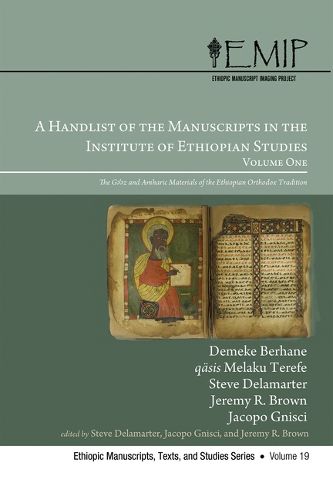Readings Newsletter
Become a Readings Member to make your shopping experience even easier.
Sign in or sign up for free!
You’re not far away from qualifying for FREE standard shipping within Australia
You’ve qualified for FREE standard shipping within Australia
The cart is loading…






This title is printed to order. This book may have been self-published. If so, we cannot guarantee the quality of the content. In the main most books will have gone through the editing process however some may not. We therefore suggest that you be aware of this before ordering this book. If in doubt check either the author or publisher’s details as we are unable to accept any returns unless they are faulty. Please contact us if you have any questions.
The Institute of Ethiopian Studies is home to the largest collection of Ethiopian manuscripts in the world. This volume provides a catalog of one subset of the manuscripts: those in Ge'ez and Amharic, which were mostly produced by members of the Ethiopian Orthodox Church. There are six introductory essays that provide information about the developments and project, which led to the digitization of the collection in 2010; the history of the IES collection; the cataloging approach; the digitization process; the rationale for undertaking this endeavor; and a short description of some of the illuminated manuscripts in the IES. The catalog provides short handlist entries for 1,530 in the IES that were prepared by qasis Melaku Terefe with assistance from Steve Delamarter and Jeremy Brown. The final passes were carried out by Jacopo Gnisci and Jeremy Brown, with special attention to technical matters of cataloguing, lists, and indexing. Back matter includes lists of IES Manuscripts arranged by shelf mark and a concordance with pieces microfilmed by the EMML Project, as well as lists of dated or datable and undated codices and magic scrolls. These are followed by indexes of works, miniatures, names, and places in the manuscripts and an index of names of owners in the magic scrolls. Forty-two plates showcase in full detail some highlights from the collection.
$9.00 standard shipping within Australia
FREE standard shipping within Australia for orders over $100.00
Express & International shipping calculated at checkout
Stock availability can be subject to change without notice. We recommend calling the shop or contacting our online team to check availability of low stock items. Please see our Shopping Online page for more details.
This title is printed to order. This book may have been self-published. If so, we cannot guarantee the quality of the content. In the main most books will have gone through the editing process however some may not. We therefore suggest that you be aware of this before ordering this book. If in doubt check either the author or publisher’s details as we are unable to accept any returns unless they are faulty. Please contact us if you have any questions.
The Institute of Ethiopian Studies is home to the largest collection of Ethiopian manuscripts in the world. This volume provides a catalog of one subset of the manuscripts: those in Ge'ez and Amharic, which were mostly produced by members of the Ethiopian Orthodox Church. There are six introductory essays that provide information about the developments and project, which led to the digitization of the collection in 2010; the history of the IES collection; the cataloging approach; the digitization process; the rationale for undertaking this endeavor; and a short description of some of the illuminated manuscripts in the IES. The catalog provides short handlist entries for 1,530 in the IES that were prepared by qasis Melaku Terefe with assistance from Steve Delamarter and Jeremy Brown. The final passes were carried out by Jacopo Gnisci and Jeremy Brown, with special attention to technical matters of cataloguing, lists, and indexing. Back matter includes lists of IES Manuscripts arranged by shelf mark and a concordance with pieces microfilmed by the EMML Project, as well as lists of dated or datable and undated codices and magic scrolls. These are followed by indexes of works, miniatures, names, and places in the manuscripts and an index of names of owners in the magic scrolls. Forty-two plates showcase in full detail some highlights from the collection.